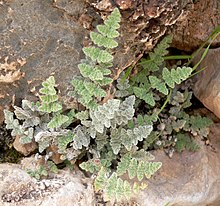Cheilanthes
| Cheilanthes | |
|---|---|

| |
| Cheilanthes parryi | |
| Scientific classification | |
| Kingdom: | Plantae |
| Clade: | Tracheophytes |
| Division: | Polypodiophyta |
| Class: | Polypodiopsida |
| Order: | Polypodiales |
| Family: | Pteridaceae |
| Subfamily: | Cheilanthoideae |
| Genus: | Cheilanthes Sw.[1] |
| Type species | |
| Cheilanthes micropteris Sw.
| |
| Species | |
|
See text | |
| Synonyms | |
| |
Cheilanthes, commonly known as lip ferns,[2] is a genus of about 180 species of rock-dwelling ferns with a cosmopolitan distribution in warm, dry, rocky regions, often growing in small crevices high up on cliffs. Most are small, sturdy and evergreen. The leaves, often densely covered in trichomes, spring directly from the rootstocks. Many of them are desert ferns, curling up during dry times and reviving with the coming of moisture. At the ends of veins sporangia, or spore-bearing structures, are protected by leaf margins, which curl over them.
Taxonomy
[edit]The genus name is derived from the Greek words χεῖλος (cheilos), meaning "lip," and ἄνθος (anthos), meaning "flower."[3]
Cheilanthes as traditionally circumscribed is now known to be highly paraphyletic, comprising at least four generically separate groups. The type species, C. micropteris, is most closely allied to the genera Aleuritopteris and Sinopteris (Schuettpelz et al.). In the early 21st century, many species, principally from the New World, were moved into the new genus Gaga and the revived genus Myriopteris. Further work remains to be done to render Cheilanthes monophyletic. Members of many other cheilanthoid genera have at times been given names in the genus.
Species
[edit]The circumscription of the genus was uncertain as of January 2020[update]. The Checklist of Ferns and Lycophytes of the World lists species in several distinct groups.[4]
Cheilanthes sensu stricto contains about 20 species from North and tropical Central and South America:[5]
- Cheilanthes arequipensis (Maxon) R.M.Tryon & A.F.Tryon
- Cheilanthes fractifera Tryon
- Cheilanthes glutinosa M.Kessler & A.R.Sm.
- Cheilanthes incarum Maxon
- Cheilanthes incisa Kunze ex Mett.
- Cheilanthes juergensii Rosenst.
- Cheilanthes laciniata Sodiro
- Cheilanthes leonardii Maxon
- Cheilanthes leucopoda Link
- Cheilanthes lonchophylla (R.M.Tryon) R.M.Tryon & A.F.Tryon
- Cheilanthes macleanii (J.Sm.) Hook.
- Cheilanthes mathewsii Kunze
- Cheilanthes micropteris Sw.
- Cheilanthes pantanalensis E.L.M.Assis, Ponce & Labiak
- Cheilanthes peruviana (Desv.) Moore
- Cheilanthes poeppigiana Mett. ex Kuhn
- Cheilanthes rufopunctata Rosenst.
- Cheilanthes sarmientoi Ponce
- Cheilanthes spiculata Mickel
- Cheilanthes squamosa Gill. ex Hook. & Grev.
- Cheilanthes volcanensis de la Sota
Cheilanthes sensu lato contains about 50 species that molecular phylogenetic studies suggest do not form a clade with the core Cheilanthes species, falling into separate clades, but for which no placement outside Cheilanthes was available as of November 2019[update]:[6]
- Cheilanthes adiantoides T.C.Chambers & P.A.Farrant
- Cheilanthes angustifrondosa Alston
- Cheilanthes austrotenuifolia H.M.Quirk & T.C.Chambers
- Cheilanthes bergiana Schltdl.
- Cheilanthes boivinii Mett. ex Kuhn
- Cheilanthes bolborrhiza Mickel & Beitel
- Cheilanthes bonapartei J.P.Roux
- Cheilanthes botswanae Schelpe & N.C.Anthony
- Cheilanthes brownii (Desv.) Domin
- Cheilanthes buchananii (Baker) Domin
- Cheilanthes capensis (Thunb.) Sw.
- Cheilanthes caudata R.Br.
- Cheilanthes ceterachoides A.W.Klopper & Klopper
- Cheilanthes contracta Kunze
- Cheilanthes deboeri Verdc.
- Cheilanthes deltoidea Kunze
- Cheilanthes depauperata Baker
- Cheilanthes dinteri Brause
- Cheilanthes distans (R.Br.) Mett.
- Cheilanthes dolomiticola (Schelpe) Schelpe & N.C.Anthony
- Cheilanthes eckloniana (Kunze) Mett.
- Cheilanthes erythraea Pic. Serm.
- Cheilanthes fragillima F.Muell.
- Cheilanthes hastata (L. fil.) Kunze
- Cheilanthes hirta Sw.
- Cheilanthes inaequalis (Kunze) Mett.
- Cheilanthes induta Kunze
- Cheilanthes involuta (Sw.) Schelpe & N.C.Anthony
- Cheilanthes kunzei Mett.
- Cheilanthes lasiophylla Pic. Serm.
- Cheilanthes leachii (Schelpe) Schelpe
- Cheilanthes lozanoi (Maxon) R.M.Tryon & A.F.Tryon
- Cheilanthes madagascariensis Baker
- Cheilanthes marlothii (Hieron.) Schelpe
- Cheilanthes muelleri (Hook.) comb. ined.
- Cheilanthes multifida (Sw.) Sw.
- Cheilanthes namaquensis (Baker) Schelpe & N.C.Anthony
- Cheilanthes nielsii W.Jacobsen
- Cheilanthes nitida (R.Br.) P.S.Green
- Cheilanthes parviloba (Sw.) Sw.
- Cheilanthes pentagona Schelpe & N.C.Anthony
- Cheilanthes perlanata (Pic. Serm.) Kornas
- Cheilanthes perrieri J.P.Roux
- Cheilanthes praetermissa D.L.Jones
- Cheilanthes prenticei Luerss.
- Cheilanthes pumilio (R.Br.) F.Muell.
- Cheilanthes quadripinnata (Forsk.) Kuhn
- Cheilanthes reynoldsii (F.Muell.) comb. ined.
- Cheilanthes robusta (Kunze) Tryon
- Cheilanthes sieberi Kunze
- Cheilanthes similis Ballard
- Cheilanthes skinneri (Hook.) R.M.Tryon & A.F.Tryon
References
[edit]- ^ a b "Genus: Cheilanthes Sw". Germplasm Resources Information Network. United States Department of Agriculture. 2007-10-05. Archived from the original on 2015-09-23. Retrieved 2011-06-07.
- ^ "Cheilanthes". Integrated Taxonomic Information System. Retrieved 2011-10-23.
- ^ Moran, Robbin Craig (2004). A Natural History of Ferns. Timber Press. p. 94. ISBN 978-0-88192-667-5.
- ^ a b Hassler, Michael & Schmitt, Bernd (November 2019). "Search for Cheilanthes". Checklist of Ferns and Lycophytes of the World. 8.11. Archived from the original on 2017-09-02. Retrieved 2020-01-02.
- ^ Hassler, Michael & Schmitt, Bernd (November 2019). "Search for Cheilanthes Sw.". Checklist of Ferns and Lycophytes of the World. 8.11. Archived from the original on 2017-09-02. Retrieved 2020-01-02.
- ^ Based on searching for all Cheilanthes species and removing those found by searching for "Cheilanthes Sw." in the Checklist of Ferns and Lycophytes of the World.[4]
- Flora Europaea: Cheilanthes
- Flora of North America: Cheilanthes
- Cheilanthes glauca pictures from Chilebosque.
- "lip fern." Encyclopædia Britannica Online. 30 Nov 2007.
